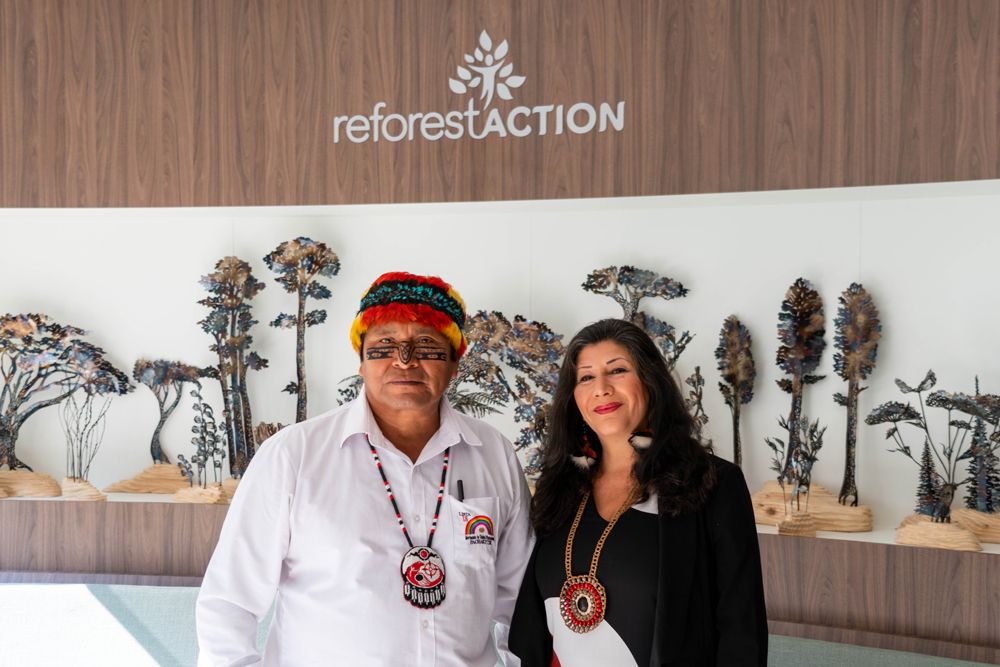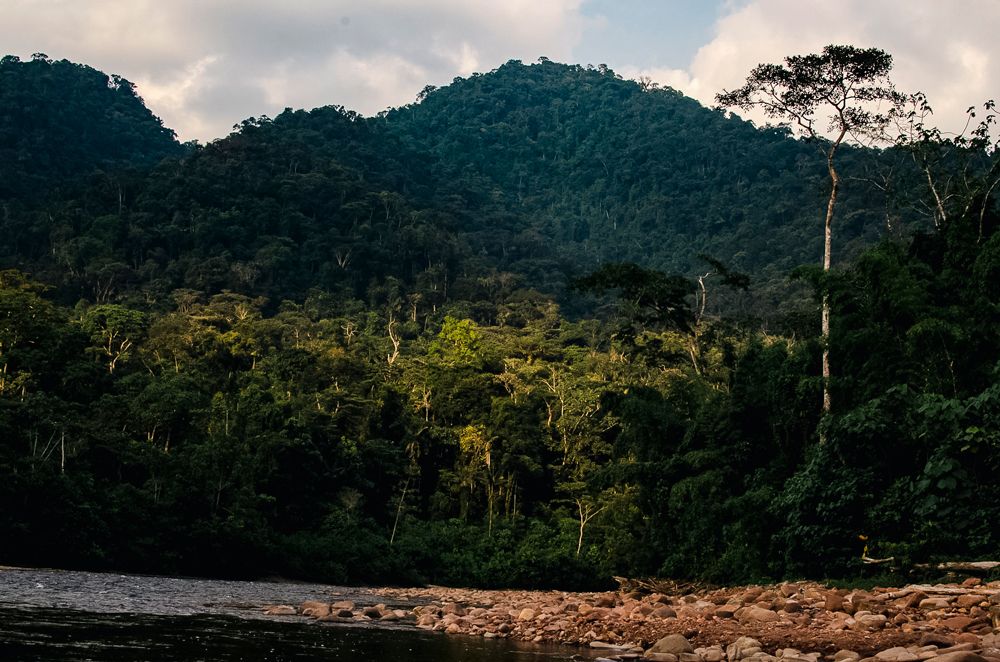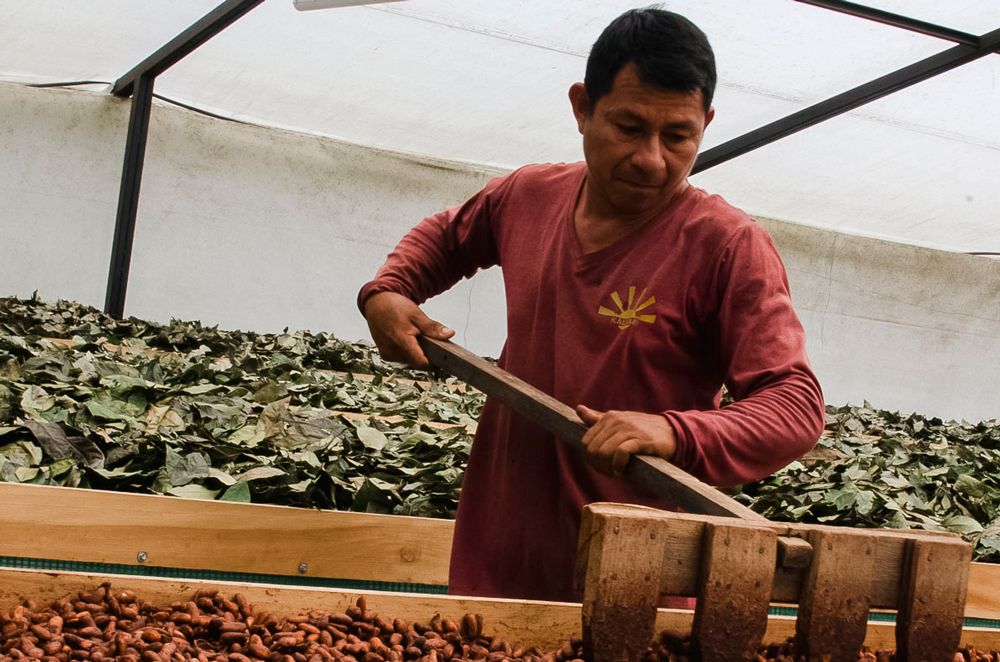The Amazon rainforest and the ancestral knowledge it contains are in danger of disappearing as the forest is exploited for its natural resources and converted to intensive agriculture. Home to 1,5 million of indigenous people who depend directly on its ecosystem services for their livelihoods, Amazonia also contains 10% of the world's terrestrial biodiversity and 20% of the world's freshwater reserves. Located between two affluents of the Amazon, on either side of the border between Ecuador and Peru, the Sacred Headwaters region, the richest reservoir of biodiversity in Amazonia, is particularly affected by oil extraction and the deforestation that precedes it. During a visit to the Reforest'Action offices, Domingo Peas Nampichkai, leader of the Achuar Amazonian people, and Atossa Soltani, director of the Amazon Sacred Headwaters Initiative, discussed the urgent need to preserve this region, which is essential to the ecosystemic balance of the Amazon rainforest, and the ambition of the project led by an alliance of indigenous organisations and to which Reforest'Action is contributing.

The Sacred Headwaters, essential to the ecosystem balance of the Amazon rainforest
With a deforestation rate of 17%, the Amazon is close to its tipping point
The Amazon rainforest is one of the three largest primary forests in the world, covering 550 million hectares, or almost 5% of the earth's surface. It contains 20% of the world's freshwater reserves through its 6,600 kilometres of rivers and 10% of the known plant and animal species on Earth. It is also home to more than 34 million people, including 1,5 million of indigenous people distributed across 385 ethnic groups, who depend directly on the services provided by the forest - in particular its water sources, fruits, berries and medicinal plants - for their livelihoods.
Threatened by the extraction of natural resources such as wood, oil and minerals, but also by industrial agriculture, in particular the cultivation of soya, oil palm and intensive livestock farming, the Amazon rainforest is approaching a tipping point. If 17% of the Amazon basin has already been deforested to date, the entire ecosystem would collapse definitively, with no possibility of being restored, if this rate were to reach 25%.
Its destruction is not just a regional issue. In the current context of the global climate and biodiversity crisis, the whole planet is being impacted by this large-scale degradation. The hundreds of billions of trees in the Amazon biome absorb more than a billion tonnes of CO2 a year, equivalent to approximately 4% of global fossil fuel emissions, and therefore play a critical role in stabilising the global climate. However, recent studies suggest that deforestation is turning the Amazon rainforest into a source of carbon emissions, since the felled trees are releasing more CO2 than those still standing are absorbing. Interviewed at the Reforest'Action offices, Domingo Peas Nampichkai, leader of the Achuar Amazonian people, stresses the urgent need to restore this unique ecosystem: "By regulating the water cycle and purifying the air, the Amazon ecosystem is at the heart of the world. Preserving it should everyone's concern".


The Sacred Headwaters : the richest reservoir of biodiversity in Amazonia threatened by the extractive industries
Located between two affluents of the Amazon, the Napo River (Ecuador) and the Marañon River (Peru), the Amazon Sacred Headwaters bioregion, also known as Cuencas Sagradas in Spanish, stretches across the border between Ecuador and Peru, covering an area of 35 million hectares - the size of California. It is the richest reservoir of biodiversity in the Amazon and contains several endemic and critically endangered animal species, including the Rio Mayo titi (Callicebus oenanthe) and the Ecuadorian white-fronted capuchin (Cebus aequatorialis). It helps maintain the hydrological cycle of the American continents and the ecosystem balance of the entire Amazon basin. It is also home to 600,000 people belonging to 30 indigenous peoples, representing 20% of the total indigenous population of Amazonia. These include the Waorani, the Kichwa and the Achuar, to which Domingo Peas Nampichkai belongs. "The Amazon is like a nurturing mother for indigenous peoples. It is a source of food, medicine and wisdom for us", he explains. "We are the sons and daughters of our Mother Earth, of our Pachamama, and we must return the help that the forest has given us, and take care of it in our turn."
However, the Amazon Sacred Headwaters region is particularly affected by oil exploitation and the deforestation that precedes it. Outside the Yasuni National Park, an area protected by the Ecuadorian government, the extractive industries are imposing their activities on the very territories of the indigenous populations. Not far from the Sacred Headwaters, the Lago Agrio region remains deeply scarred by the largest oil slick in Ecuador's history, associated with the American oil company Chevron and its subsidiary Texaco, which between 1967 and 1993 dumped more than 73 billion litres of toxic waste in the Ecuadorian Amazon, causing irreversible damage to natural ecosystems and crops, as well as fatal illnesses among the local population due to contamination of the air, water and soil.
Yet the Peruvian and Ecuadorian governments, whose economies are still heavily dependent on oil production, are only planning to protect 30% of the Sacred Headwaters region by 2030. The indigenous communities who live there consider this commitment to be woefully inadequate, as they are facing the oil industry on a daily basis and suffering the damage and pollution caused by this industry. "We have a dream", says Domingo Peas Nampichkai, "to take care of the forest for future generations - to put an end to major roadworks and to oil, mining and forestry exploitation".

Amazonian peoples join forces to protect the Sacred Headwaters
The Amazon Sacred Headwaters Initiative: an unprecedented alliance of indigenous organizations
In this context, an unprecedented alliance of indigenous organizations, bringing together the Interethnic Association for the Development of the Peruvian Rainforest (AIDESEP), the Confederation of Indigenous Nationalities of the Ecuadorian Amazon (CONFENIAE) and the Coordination of Indigenous Organizations of the Amazon Basin (COICA), joined forces in 2017 with the aim of achieving a minimum protection level for the Sacred Headwaters of 80% of its surface area by 2025. "The Amazon Sacred Headwaters Initiative was born as an alliance of 30 indigenous nations from the Ecuadorian and Peruvian Amazon, determined to work in solidarity and coordination, with a holistic vision, to permanently protect the Sacred Headwaters region, stop the advance of the extractive industry, and restore the central role of the well-being of the forest and the people who live in it", explains Atossa Soltani, interviewed by Reforest’Action. Founder and president of the NGO Amazon Watch, she is now Director of Global Strategy for the Amazon Sacred Headwaters Initiative, alongside Domingo Peas Nampichkai, who is its official coordinator and spokesperson.

A bioregional plan for the transition to an ecological model
As the first milestone in the programme supported by this alliance, a bioregional plan was presented at COP 26 in Glasgow in November 2021 by a delegation from Amazonian indigenous communities. Developed with the support of their elders, known as "sábios", and international researchers, the plan combines science with the ancestral knowledge of indigenous peoples. It aims to support the region's transition from an extractive economic model, based on oil, forestry and mining, to an ecological model that promotes the permanent protection of the Sacred Basins, the well-being of Amazonian communities and indigenous territorial governance. Through nine transition paths, the plan includes the restoration of 8 million hectares of forest destroyed by the extractive industry, as well as the development of community tourism, agroforestry and a regenerative economy.

Developing a regenerative economy in indigenous communities
Forest restoration and promotion of traditional and sustainable agroforestry systems
As part of this holistic initiative, Reforest'Action is supporting a 300-hectare pilot project dedicated to the restoration and preservation of ecosystems, as well as the development of agroforestry and a regenerative economy within indigenous communities. The project is being carried out on the ground by Fundación Pachamama, an Ecuadorian NGO, in conjunction with the Amazonian indigenous peoples, CONFENAIE (on the Ecuadorian side) and AIDESEP (on the Peruvian side). The project is also part of the Circular Bioeconomy Alliance, established by His Majesty King Charles III as part of his initiative for sustainable markets powered by nature.
"The indigenous peoples live, heal and feed themselves only thanks to the Amazon rainforest", observed Stéphane Hallaire, President and Founder of Reforest'Action, during his mission in Ecuador in March 2022 alongside Marc Palahi, Director of the European Forest Institute and President of the Circular Bioeconomy Alliance (CBA). "They embrace all its complexity and live at its pace, in contrast to the Western lifestyles we know. It is vital for them to continue to inhabit this extremely precious ecosystem. We need to initiate large-scale projects in collaboration with these communities, who are the guardians of a unique and invaluable know-how". This is precisely the objective of this project funded by Reforest'Action, which aims to promote the traditional Amazonian agroforestry system known as the chakra. The Amazonian chakra is a synergistic living space between humans, animals and plants. Often managed by women, it is a daily place where families come together to work, learn, cultivate edible resources, feed themselves and harvest medicinal plants and forest products in a circular and sustainable way. Within this programme, the emphasis will be on reintroducing and preserving native tree species such as plantain and yucca, as well as adding fruit trees and species that will create value chains, such as vanilla, macambo, patasmuyon, white cocoa and guayusa. The trees will be nurtured by indigenous communities over the long term, providing them with livelihoods and additional income as part of a circular, regenerative, nature-based bioeconomy.


Creation of a school to train indigenous communities in sustainable forest management
Reforest'Action also financed the creation of the Escuela Viva Amazónica, which was inaugurated on 9 March 2023 at the CONFENIAE headquarters in the town of Puyo, Ecuador. The school aims to train the younger generation of indigenous Amazonian communities in the creation of agroforestry systems and the sustainable management of edible forests, as well as facilitating the transmission of the knowledge of elders about medicinal plants and the whole of Amazonian culture, from its history to its arts. The ultimate aim is to encourage the emergence of new leaders from indigenous Amazonian communities so that they can take action on the international stage to protect the Amazon rainforest - like Domingo Peas Nampichkai, who concludes: "All human beings need the Amazon and the commitment must be collective. Indigenous peoples alone will not solve the problem. For the Amazon Sacred Headwaters Initiative, it is essential to create links and integrate indigenous and non-indigenous populations into the project. We will succeed by joining forces and working together.”